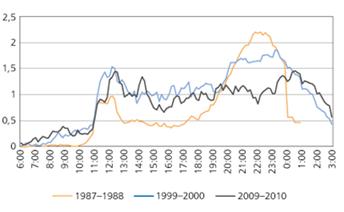Where and when do we eat?
- Time Use Survey data on eating out
- Looser patterns of mealtimes on weekends
- Eating alone and with others
- Occasions for eating out
- Less time spent at restaurants
- Income, age, attitudes and restaurant supply play a role in eating out
Koko dokumentti yhdell� sivulla
Less time spent at restaurants
To conclude, I will examine social interaction at restaurants, as socialising often is associated with having meals and drinks. This is an activity to which the Time Use Surveys of all decades have paid attention. Changes in the category names are an nice reflection of how attitudes and behavioural models have changed. In 1979 and in 1987−1988, there were two categories of activities, titled Going to restaurants and dancing and Sitting in bars. A decade later, this activity was called Socialising at restaurants, pubs etc. and, in the latest study, Socialising at caf�s or restaurants.
At the national level, it seems that the time we spend at restaurants has declined steadily from what it was thirty years ago. This is the result of fewer people spending their time at restaurants. The slow but steady decline in the number of those engaged in this activity may also have been affected by a demographic change. In 1979, the large age groups were in their thirties and thus at an optimal age for spending time at restaurants. The time we spend at restaurants varies rather significantly depending on our stage in life, and this phenomenon has changed little over the decades. Even the latest study indicates that the heaviest users of restaurants, caf�s or pubs are young people (aged under 45) who live alone. They spend time at these establishments both during the week and at the weekend. Young childless couples spend a lot of time in restaurants and caf�s during the weekend, as do single parents. Couples aged 45 or over spend the least time socialising in restaurants, caf�s and pubs. In 2009−2010, they spent less than a minute a day on this activity, whereas those aged under 45 living alone spent 25 minutes on it.
Figure 6 shows the proportion of the population aged 10 or over that was at a restaurant at various times of the day. Socialising at a restaurant takes place in the evening, while having meals is more evenly distributed during the day. The figure describes the situation in the entire country and the average for all days. While on average, only one per cent of the population aged 10 or over spend time at restaurants, the figure is considerably higher on Saturdays. In the Helsinki Metropolitan area, this share varied between 5 and 9 per cent on Saturday evenings. However, Figure 6 describes a change in the role of restaurants over the various decades. In the late 1980s, people specifically went to restaurants to spend time and dance, whereas the time spent having a meal or socialising in a bar was considerably shorter than today. The evening was over around midnight, as this was the closing time for most places.
Figure 6. Distribution of visits to restaurants, caf�s and pubs over the hours of the day in 1987−1988, 1999−2000 and 2009−2010. Percentage of population aged 10 or over on an average day of the year engaged in this activity.

Source: Statistics Finland. Time Use Survey.
At the turn of the millennium, people were more likely to have a meal, and not just at lunch time. The time spent at restaurants in the afternoon was considerably longer than in the late 1980s, and people stayed out later at night. The latest Time Use Survey from 2009−2010 indicates that the time we spend in restaurants and caf�s is rather evenly divided throughout the day. Lunchtime and after midnight stand out as tentative peak times. Two peaks for having meals can be observed around lunch time. The latter is explained by the later meal times on weekends, in practice on Saturday. It appears that socialising at restaurants in the evenings starts even later than before and continues for slightly longer.
The differences between the weekend and weekdays in eating at restaurants are major in the Helsinki Metropolitan area and Northern Finland, but minor elsewhere in Finland. This is likely to reflect differences in the occasions of and the reasons for eating out. In the Helsinki Metropolitan area, it is easy to go out for a meal in your free time. On weekdays, eating out is likely to be mainly associated with working time.
P�ivitetty 20.3.2013
